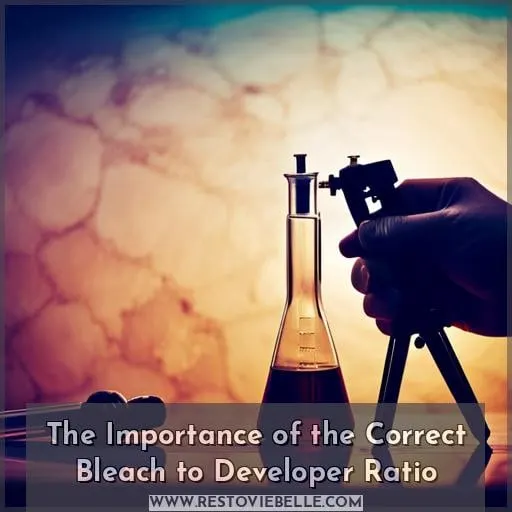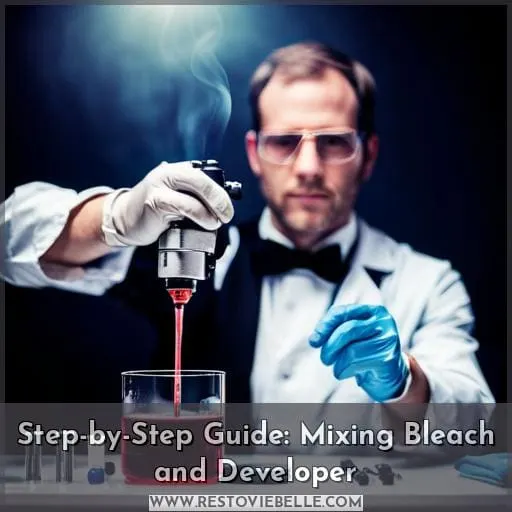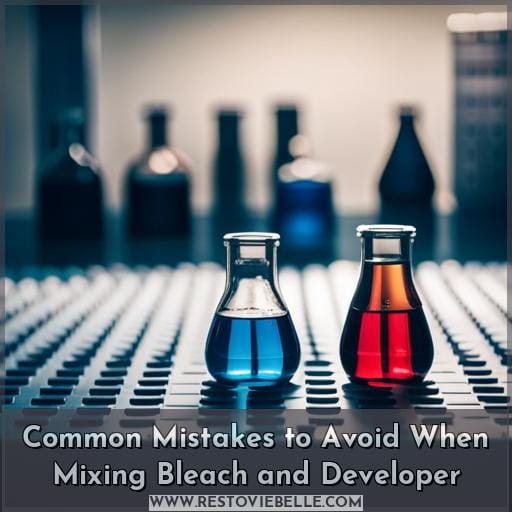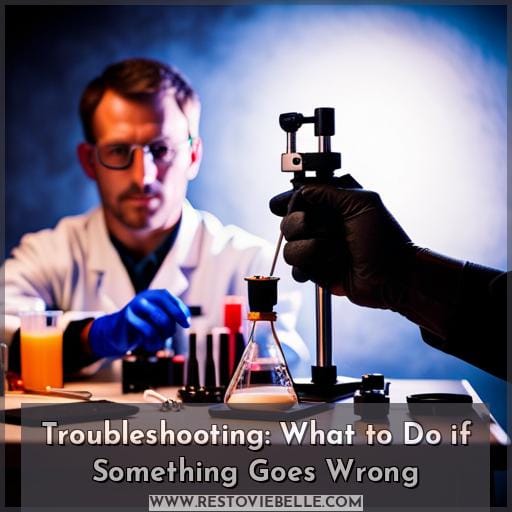This site is supported by our readers. We may earn a commission, at no cost to you, if you purchase through links.
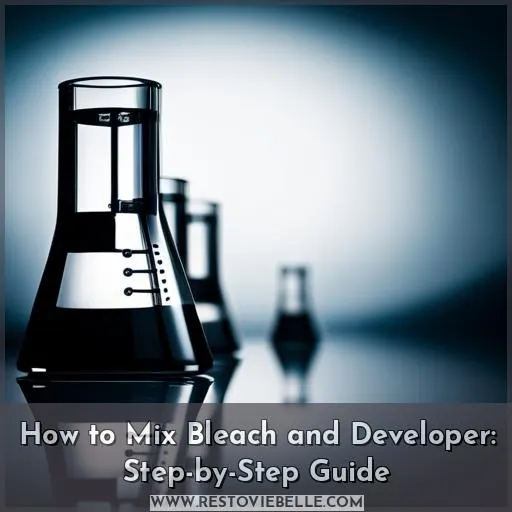 Ready to take matters into your own hands and lighten up your hair? Mixing bleach and developer is a great way to get the job done, but it’s important that you do it right. To give yourself salon-quality results, follow this step-by-step guide on how to mix bleach with developer.
Ready to take matters into your own hands and lighten up your hair? Mixing bleach and developer is a great way to get the job done, but it’s important that you do it right. To give yourself salon-quality results, follow this step-by-step guide on how to mix bleach with developer.
We’ll walk you through everything from choosing the right ingredients for your hair type, understanding the correct ratio of bleach and developer for optimal lightening power, performing skin tests before application – plus tips on how to protect your hair during bleaching as well as common mistakes so you can avoid them when mixing these two powerful chemicals together.
With our help, achieving beautiful blonde locks while minimizing damage will be easy!
Table Of Contents
- Key Takeaways
- Understanding Hair Bleaching: How Does It Work?
- Choosing the Right Bleach for Your Hair
- Selecting the Appropriate Developer for Your Hair Type
- The Importance of the Correct Bleach to Developer Ratio
- Step-by-Step Guide: Mixing Bleach and Developer
- Determining the Right Developer Volume for Your Desired Lightening Level
- Performing Skin and Hair Tests Before Application
- Tips for Minimizing Damage and Maintaining Hair Health During and After Bleaching
- Common Mistakes to Avoid When Mixing Bleach and Developer
- Troubleshooting: What to Do if Something Goes Wrong
- Conclusion
Key Takeaways
- Different developer volumes are available for varying lightening intensities and hair types.
- The recommended mixing ratio is 2 parts developer to 1 part bleach.
- Thoroughly mix the developer and bleach for 2 minutes to achieve a uniform consistency.
- Prior to applying the mixture to the entire hair, it is important to conduct skin and strand tests.
Understanding Hair Bleaching: How Does It Work?
By understanding the interaction between bleach and developer, you can effectively lighten your hair while protecting its health. Bleach is designed to remove pigment from hair, while developer contains hydrogen peroxide, which activates the bleach and eliminates natural color.
Different volumes offer varying levels of bleaching power: 10 Vol for mild lightening; 20 Vol for general use; 30 Vol in salons; 40 Vol for intense results.
To maintain a consistent ratio of 2 parts developer to 1 part bleach, gather materials including a bowl, brush, and gloves before starting the process. Conduct tests on the skin or a strand test prior to application to ensure accuracy when measuring ingredients.
Follow best practices afterwards, such as preventing greening and minimizing loss, so that the desired result is achieved without damaging your hair’s structure with chemical reactions due to improper mixing of bleach and developer ratios!
Choosing the Right Bleach for Your Hair
Now that you understand how hair bleaching works, it’s time to select the right bleach for your hair. Choosing techniques, compatibility with existing color and scalp conditions, color correction goals, and gradual lightening are all essential factors in selecting the best product for your needs.
Consider Your Hair Type: Different bleaches work better on certain types of strands – from straight to curly or thick to thin – so be sure you choose one that is appropriate for yours.
Determine Bleach-to-Developer Ratio: The recommended ratio is two parts developer per one part bleach; however, this may vary depending on the volume of developer used (10 Vol – 40 Vol).
Perform Tests Before Applying Mixture: A patch test should be performed before applying any mixture containing bleach as some individuals may have allergic reactions or experience unexpected results without proper testing first! When followed correctly, these steps will help ensure an effective result while protecting against damage.
Due diligence when mixing bleach and developer can go a long way towards achieving desired results safely at home!
Selecting the Appropriate Developer for Your Hair Type
With your hair type in mind, carefully select the appropriate developer to get the desired lightening results. Developer volume effects range from mild lightening with 10 Vol and common salon use at 30 Vol, to intense professional-level bleaching with 40 Vol.
It’s important to choose wisely based on your goals and sensitivity of hair. For optimal results, purchase products from the same brand for both bleach and developer when mixing them together according to a 2:1 ratio – two parts developer for one part bleach – using plastic bowls, brushes, or measuring tools for accuracy.
Consider consulting an expert if you have chemically treated or fragile hair prior to the bleaching process. Additionally, minimize damage after by following best practices, including regular deep conditioning treatments.
With careful selection of the appropriate product matched with proper technique, you can achieve desirable results without compromising the health of your locks.
The Importance of the Correct Bleach to Developer Ratio
It’s essential to maintain a consistent ratio between bleach and developer for effective hair bleaching. Balancing the two components is key, as too much bleach can burn your scalp or cause discoloration, while an excess of developer may not provide enough lifting power.
Having measuring tools like a scale or cups will make sure you have the right proportions every time. Achieving consistency also prevents over-bleaching and protects your hair from damage by avoiding excess concentrations of chemicals that could be damaging in large amounts.
Mixing 2 parts developer with 1 part bleach powder should do the trick. If you don’t have access to measuring tools, match up container sizes according to this ratio for best results!
Ultimately, understanding how important it is to measure correctly will give you perfect lightening results without compromising the safety and healthiness of your hair!
Step-by-Step Guide: Mixing Bleach and Developer
Before you begin bleaching your hair, it is essential to gather the necessary materials and measure out the correct ratio of bleach and developer. Achieving a homogeneous mixture is key for successful results, which means consistency must be maintained throughout the process.
Gathering the Materials
Before you get started, gather all the necessary materials for mixing bleach and developer. You will need a plastic bowl, brush, gloves, and aluminum foil if needed. It’s important to be prepared with an explosion of hair lightening potential.
Consider gathering techniques like measuring tools or weighing ingredients to ensure accuracy. Safety precautions are key when dealing with hydrogen peroxide, so use the right tools: gloves and a plastic bowl.
If you are adding highlights, wrap them in aluminum foil before applying them to your head. This will help achieve successful results. It is also recommended that you use the same brand for both bleach and developer.
Measuring the Ingredients
Using measuring tools or weighing the ingredients, make sure you have an accurate ratio between your developer and bleach. Achieving a homogenous mixture of 2 parts developer to 1 part bleach is crucial for effective on-scalp applications and desired hair color results.
Incorporate precision into your mixing techniques by accurately proportioning the ingredients.
If access to measuring tools is limited, always choose matching container sizes based on the recommended ratio instead of guessing amounts.
With precise measurements and careful blending, there’s no need to fear bleaching at home.
Achieving a Homogeneous Mixture
Vigorously stirring the ingredients together with a brush helps create a homogeneous mixture, and consistent results can be achieved with just 2 minutes of mixing.
For best outcomes, use measuring tools or weigh the components to stay on track!
To ensure uniformity throughout your mix, scrape down any clumps that may form during blending. This will ensure an even texture for optimal lightening effects when bleaching your hair.
Additionally, you should switch up your mixing techniques from time to time. This prevents lumps from forming in between batches and allows you to check consistency more easily when making subsequent mixtures of bleach and developer at home!
The Role of Consistency
Maintaining a consistent ratio between bleach and developer is key to achieving the desired lightening results without damaging your hair. Mixing techniques should be done with care, paying attention to uniformity in order to avoid over-bleaching or uneven coloration.
To ensure an even blend, mix vigorously while performing consistency checks throughout the process. A textural balance must be struck by removing any clumps that form during mixing for optimal results when bleaching hair at home.
Determining the Right Developer Volume for Your Desired Lightening Level
When it comes to lightening hair, choose the developer volume wisely for your desired outcome.
- 10 Vol is mild lightening; 20 Vol is a popular choice for general use; 30 Vol is commonly used in salons; 40 vol provides intense lightening.
- Avoid damaging hair by patch testing and following best practices when bleaching.
- For fragile or chemically treated hair, gradual bleaching plans are recommended from experts.
- Maintain consistency of 2 parts developer to 1 part bleach ratio regardless of the chosen volume level—measure ingredients accurately using measuring tools or match sizes based on the ratio if needed!.
Mixing bleach and developer correctly helps achieve desirable results without compromising the health of your locks! Take into account the intended impact before choosing which strength works best for you—and don’t forget to perform skin & strand tests prior to application as an added precautionary measure towards protecting precious strands from any potential allergic reactions.
Performing Skin and Hair Tests Before Application
Before you apply the bleaching mixture to your hair, take a few precautions. Conduct a patch test on your skin and a strand strength test on one section of hair to identify potential allergic reactions or unwanted outcomes.
Doing so will help ensure that the bleaching process goes smoothly without any scalp irritation or unexpected results.
Be sure to check for scalp sensitivity too, as this may cause an allergic reaction if not accounted for during pre-application tests. Bleaching can be safe and effective with proper preparation; however, it’s important to exercise caution when working with strong chemicals like bleach and developer in order to avoid damaging your hair or experiencing adverse effects from an incompatible mix of ingredients.
Taking these extra steps before diving into at-home color treatments is highly recommended.
Tips for Minimizing Damage and Maintaining Hair Health During and After Bleaching
To protect your hair’s health after bleaching, there are several tips to consider. First and foremost, use a full head bleach instead of highlights or balayage for less breakage.
Second, deep condition with a protein treatment that targets weakened areas.
Thirdly, apply heat protection whenever using styling tools such as curling irons or blow dryers to minimize further damage.
Additionally, opt for a sulfate-free shampoo when washing your hair and follow it up with an intense moisturizing deep conditioner at least once per week afterwards in order to maintain softness and shine without stripping away natural oils from the scalp.
Lastly but not least important is pre-bleach care; focus on strengthening the strands before taking drastic measures such as bleaching by using hydrating masks regularly prior to lightening sessions in order achieve longer lasting results while combating possible breakage caused by chemical treatments like developer mixed with bleach mixes.
Common Mistakes to Avoid When Mixing Bleach and Developer
When mixing developer and bleach, there are a few common mistakes you should avoid in order to achieve your desired results without causing damage.
Incorrect proportions of 2:1 between the two products can lead to undesired lightening or under-lightening.
Skipping tests on hair strands and skin patches is also an issue as it will cause unexpected outcomes that could be irritating or damaging for your hair.
Overmixing the ingredients leads to clumping which makes application difficult, while using wrong developers may result in scalp irritation or unnatural colors when bleaching already colored hair.
Neglecting safety measures such as wearing gloves may expose you to harmful chemicals found in these products and avoiding proper root area application can cause unevenness with the final outcome leading to breakage from over processing at certain areas of your head.
Be mindful of these details when mixing bleach and developer so you won’t have any regrets later on!
Troubleshooting: What to Do if Something Goes Wrong
If something goes wrong during the bleaching process, don’t despair; there are steps you can take to troubleshoot and potentially fix the issue. Uneven lightening solutions, such as color correction techniques, may be necessary to address patches of unwanted colors.
If your hair is sensitive, use a bleach wash instead of ammonia-based dyes to fade out any mistakes or reactivate the bleach mix with developer if it has dried up before application.
Additionally, dealing with orange or yellow tones after bleaching can be resolved by using toners instead of harsher chemical treatments like permanent hair dye, which could further damage already fragile locks.
To prevent patchy results in future attempts at home bleaching processes, make sure that all sections are properly saturated and timed correctly.
Conclusion
Mixing bleach and developer is an essential step to hair bleaching. Get it right, and you’ll be rewarded with the perfect shade of blonde. Get it wrong, and you could be left with green-tinged hair and irreversible damage.
With the right knowledge and a bit of practice, anyone can learn how to mix bleach and developer for the desired result. Begin by understanding the interaction between the two components and selecting an appropriate developer volume.
Then, gather the necessary materials, measure the ingredients, and mix them until a homogeneous mixture is achieved. Don’t forget to do skin and hair tests before application and use the tips provided to minimize damage and maintain hair health.
With these steps, you’ll be able to mix developer and bleach like a professional!




